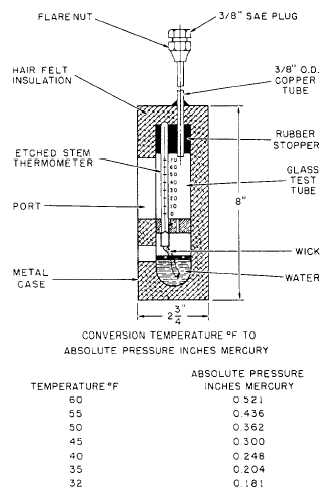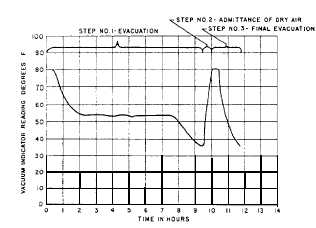will result in reduced capacity of the plant, low
compressor suction pressure, and a tendency for the
compressor to short-cycle. The maximum time interval
between defrostings depends on such factors as
condition of door gaskets, moisture content of supplies
placed in boxes, frequency of opening doors,
atmospheric humidity, and refrigerant evaporating
temperatures.
You should always defrost the cooling coils before
the frost thickness reaches three-sixteenths of an inch.
When defrosting the coils, be sure that you do NOT try
to scrape or break the frost off. Improper defrosting will
cause serious damage to the coils.
EVACUATING AND DEHYDRATING THE
SYSTEM
In areas where moisture accumulation must be
corrected, the system should first be cleared of
refrigerant and air. The time required will depend upon
the size of the system and the amount of moisture
present. It is a good engineering practice to circulate
heated air through a large dehydrator system for several
hours, or as long as the dehydrator drying agent remains
effective, before proceeding with the evacuation
process. If possible, the dehydrated air should be heated
to about 240°F.
Large dehydrators, suitable for preliminary
dehydration of refrigeration systems, are usually
available at naval shipyards and on board tenders and
repair ships. After the preliminary dehydration, the
remaining moisture is evacuated by means of a
two-stage, high-efficiency vacuum pump having a
vacuum indicator. (These vacuum pumps are available
on board tenders and repair ships.)
The vacuum indicator shown in figure 5-4 consists
of an insulated test tube containing a wet-bulb
thermometer with its wick immersed in distilled water.
The indicator is connected in the vacuum pump suction
line. The suction line from the vacuum pump is
connected to the refrigeration system. The refrigerant
circuit should be closed to the atmosphere and the
charging connection opened to the vacuum pump.
A two-stage vacuum pump is started for operation
in PARALLEL so that maximum displacement may be
obtained during the initial pump-down stages. When the
indicator shows a temperature of about 55°F (0.43
in.Hg, absolute), the pumps are placed in SERIES
operation (where the discharge from the first step enters
the suction of the second step pump). The dehydration
process will produce a temperature drop of the vacuum
Figure 5-4.—Dehydrator vacuum indicator.
indicator as shown in figure 5-5. Readings will initially
reflect ambient temperatures, then show rapidly falling
temperatures until the water in the system starts to boil.
When most of the evaporated moisture has been
evacuated from the system, the indicator will show a
Figure 5-5.—Vacuum indicator readings plotted during
dehydration.
5-10



